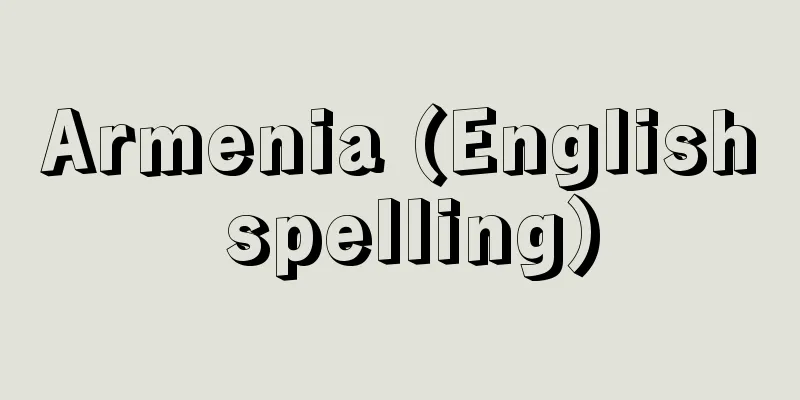Armenia (English spelling)

|
Official name: Republic of Armenia Hayastani Hanrapetut'yun (Armenian). Area: 29,743 km2 . Population: 3.1 million (2011 estimate). The capital is Yerevan. A country in the southern part of the Late Caucasus region. It borders Georgia to the north, Azerbaijan to the east, Iran to the south, and Turkey to the west. More than 90% of the country is on highlands above 1000m above sea level, and its topography is roughly divided into the Lesser Caucasus Mountains in the north and the Armenian Plateau in the south. The only large plains are in the southwest, in the Ararat Plain at the southern foot of Mount Aragats. The climate is continental and dry except on the mountain slopes, but there are significant regional differences. The average temperature is -5°C in the plains and foothills in January, -12°C in the mountains, and 25°C in the plains in July. It belongs to steppe and semi-desert areas, and irrigation agriculture is well developed. More than 90% of the population is Armenian, with the rest being Azerbaijanis, Kurds, Russians, etc. The official language is Armenian. Armenia, a country with a long history of civilization since B.C., lost its independence in the 14th century and was occupied and controlled by other ethnic groups. In 1920, the region that was formerly part of Russia gained independence and formed the Armenian Soviet Socialist Republic. In 1936, it became a constituent republic of the Soviet Union. In 1990, the country changed its name to its current one. In September 1991, it gained independence and joined the Commonwealth of Independent States (CIS). In March 1992, it joined the United Nations. Since gaining independence, there has been an armed conflict with Azerbaijan over the ownership of the Nagorno-Karabakh Autonomous Oblast (mostly Armenian) (→Nagorno-Karabakh issue). In the agricultural sector, grapes and other fruit cultivation is popular, and sheep are grazed in the alpine grasslands. The mining and manufacturing industries include copper and molybdenum mining and processing, aluminum production using abundant hydroelectric power, chemicals (sulfuric acid, carbide, synthetic rubber, fertilizer), electrical machinery, textiles, leather and shoe manufacturing, and food (brandy, canned fruit and vegetables). The main transportation system is the railway, which also connects the country to Turkey. Armenia |
|
正式名称 アルメニア共和国 Hayastani Hanrapetut'yun (アルメニア語) 。 面積 2万9743km2。 人口 310万(2011推計)。 首都 エレバン。 ザカフカジエ (後カフカス地方) 南部の国。北はジョージア(グルジア),東はアゼルバイジャン,南はイラン,西はトルコと国境を接する。国土の 90%以上が標高 1000m以上の高地にあり,地形は北の小カフカス山脈と南のアルメニア高原に大別される。大きな平地は南西部,アラガツ山南麓に広がるアララト平野にみられるにすぎない。気候は大陸性で,山地斜面を除いて乾燥しているが,地域差が著しい。平均気温は1月平地・山麓部-5℃,山地-12℃,7月平地 25℃。ステップ,半砂漠地帯に属し,灌漑農業が発達している。住民の 90%以上がアルメニア人で,ほかにアゼルバイジャン人,クルド人,ロシア人などが住む。公用語はアルメニア語。紀元前より文明の発展したアルメニアは,14世紀にその独立を失い,以後他民族の占領・支配下に入ったが,1920年旧ロシア領内にあった地域が独立し,アルメニア=ソビエト社会主義共和国を形成。 1936年ソ連の構成共和国となった。 1990年現国名に改称。 1991年9月独立し,独立国家共同体 CISに加盟。 1992年3月国際連合加盟。独立後はナゴルノカラバフ自治州 (アルメニア人が大部分) の帰属をめぐってアゼルバイジャンとの武力紛争が続いている (→ナゴルノカラバフ問題 ) 。農業部門ではブドウをはじめとする果樹栽培が盛んで,高山草地ではヒツジの放牧が行なわれる。鉱工業では銅,モリブデンの採掘・加工,豊富な水力を利用した発電によるアルミニウム製造,化学 (硫酸,カーバイド,合成ゴム,肥料) ,電気機械,繊維,皮革・製靴,食品 (ブランデー,果実・野菜缶詰) などの工業が発達し,エレバン,キロバカン,アラベルジなどに立地している。主要交通機関は鉄道で,トルコとも連絡している。 アルメニア
|
<<: Armenian Church - Armenian Church
Recommend
Construction Officer at the Accounting Office
…Established in 1724 (Kyoho 9). In 1746 (Enkyo 3)...
fancy-leaved geranium
...In addition to single-flowered varieties, ther...
Hepburn
American film actress. Born in Connecticut. Debute...
Surface activity - Surface active agent
…On the other hand, when dissolved in an aqueous ...
Geranium shikokianum (English spelling) Geraniumshikokianum
…[Mitsuko Shimizu]. … *Some of the terminology th...
Remote Island - Ritou
An island that is separated from the mainland by ...
Settlement - Jidan
It is a settlement agreement concluded between th...
Yoshida
A castle town in Mikawa Province and a post statio...
cabbage white
...The larvae are well known as a major pest of c...
Captain John Smith
… [The era of military conquest and armed resista...
Uojimadoki
〘Noun〙 A good catch of fish in March and April. Ar...
Erinyes
…the Greek goddess of vengeance. The plural Eriny...
Macaca sinica (English spelling)
… [Kuroda Suehisa]. . . *Some of the terminology ...
Huitzilopochtli - Huitzilopochtli
...The Aztecs had their capital in the center of ...
Aemasia lichenosa (English spelling) Aemasia lichenosa
...Its thick skin, with beautiful white spots edg...









